Emma Adler
Contributor @ Hackmamba
Share this article

This comprehensive guide evaluates the best API documentation tools of 2025 across four categories: end-to-end platforms, API reference generators, tools with embedded docs, and static site generators. Each tool is assessed based on auto-generation capabilities, live collaboration, Git workflows, search functionality, and developer experience to help teams choose the right solution for their needs.
Here's our shortlist if you're looking for API documentation tools to keep up with fast-changing APIs and modern developer needs.
We've grouped the tools into four categories to help you find what fits your workflow:
- End-to-end documentation platforms
- API reference generators
- API tools with built-in docs
- Static site generators for docs-as-code
Working with hundreds of developer-facing teams informed this list. Each tool was chosen for its ability to solve everyday challenges across the documentation lifecycle, including schema-based generation, live collaboration, Git-based versioning, and AI-powered search.
In this guide, you'll find a breakdown of each tool's strengths, what it's best suited for, and where it fits in a modern documentation workflow. The goal is to help you evaluate your options faster and choose the right setup for how your team builds, ships, and maintains API documentation.
How we selected these API documentation tools
The criteria were based on the following:
- Auto-generation from OpenAPI or other schemas: No one wants to manually rewrite docs every time the API changes. So we chose tools that automatically generate and update documents from your schema, ensuring the documents remain accurate and up-to-date.
- Live collaboration and changelogs: Docs get messy when one person owns them. The selected platforms make it easy for teams to collaborate in real-time, leave comments, and track changes, reducing bottlenecks and improving speed.
- Versioning with Git workflows: Your docs should evolve with your code. Each option on the list integrates with Git, allowing you to version documentation alongside your API without extra overhead.
- Embedded guides, tutorials, and fast search: Developers need more than just endpoints. The solutions we included make adding clear onboarding guides, walkthroughs, and fast search easy to help users find answers quickly.
- Developer-first experience: If documentation isn't easy, developers will skip it. Every tool we picked is fast, clean, and designed to support real developer workflows, making docs feel like a natural part of the product.
- Automation + control: Auto-generation saves time, but shouldn't feel robotic. The tools we chose strike a balance, offering smart default customization options so documents stay accurate and human readable.
1. End-to-end documentation platforms
These tools provide all-in-one solutions that cover everything from generating reference docs to managing changelogs, guides, search, and user feedback. They're great for product managers who want more than just basic specs and need a smooth, all-in-one way to create and manage their API docs.
Want a quick look at what each tool does best? The table below summarizes the core strengths of the tools in this category.
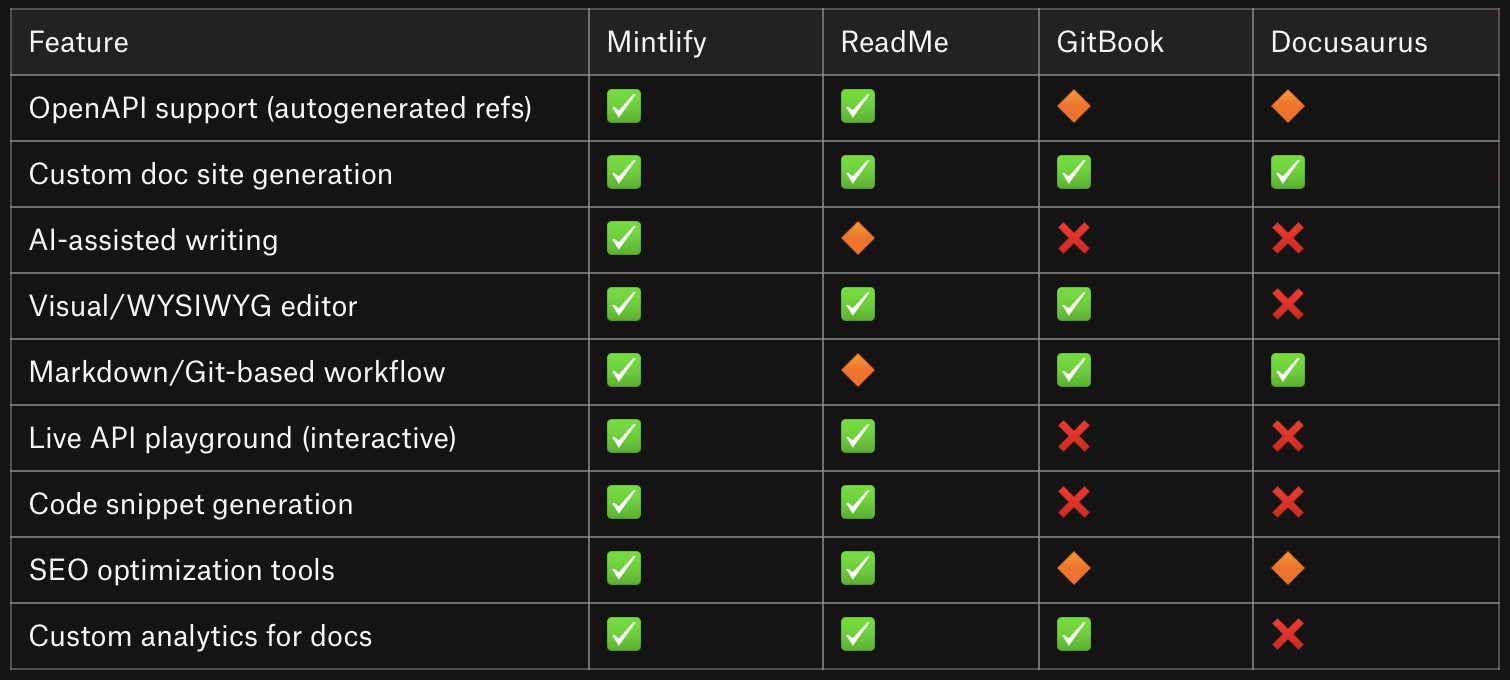
Mintlify documentation platform
Mintlify is a documentation platform that simplifies how developer teams create and maintain API documentation. It tackles common issues like outdated content and complex workflows by making it easy to generate clear, up-to-date documentation directly from your API specs.
Best suited for
It's the sole choice for teams aiming to progress quickly while maintaining high-quality documentation. If you're onboarding new developers or managing product updates often, it gives you the tools to keep docs clean, accurate, and easy to follow, without slowing anyone down.
What makes it stand out
Mintlify strikes a great balance between automation and customization, something many popular tools try to achieve but rarely get right. It automatically generates clean API documentation straight from your OpenAPI specs, which saves a ton of setup time.
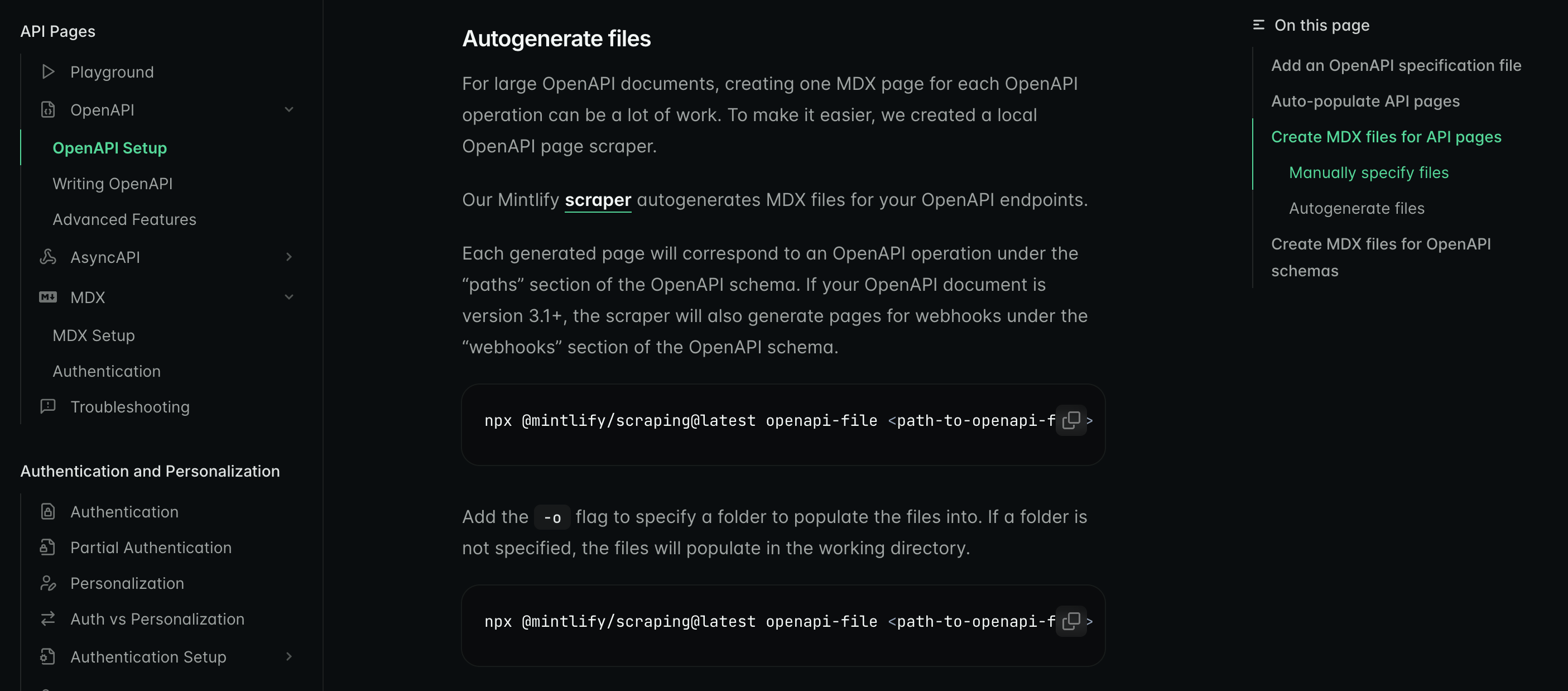
The best part is that it gives you editable MDX files you can plug right into your React or Next.js site. That means you're not stuck with a boring, default layout, and you can style your docs to match your product and even add responsive features wherever you need them.
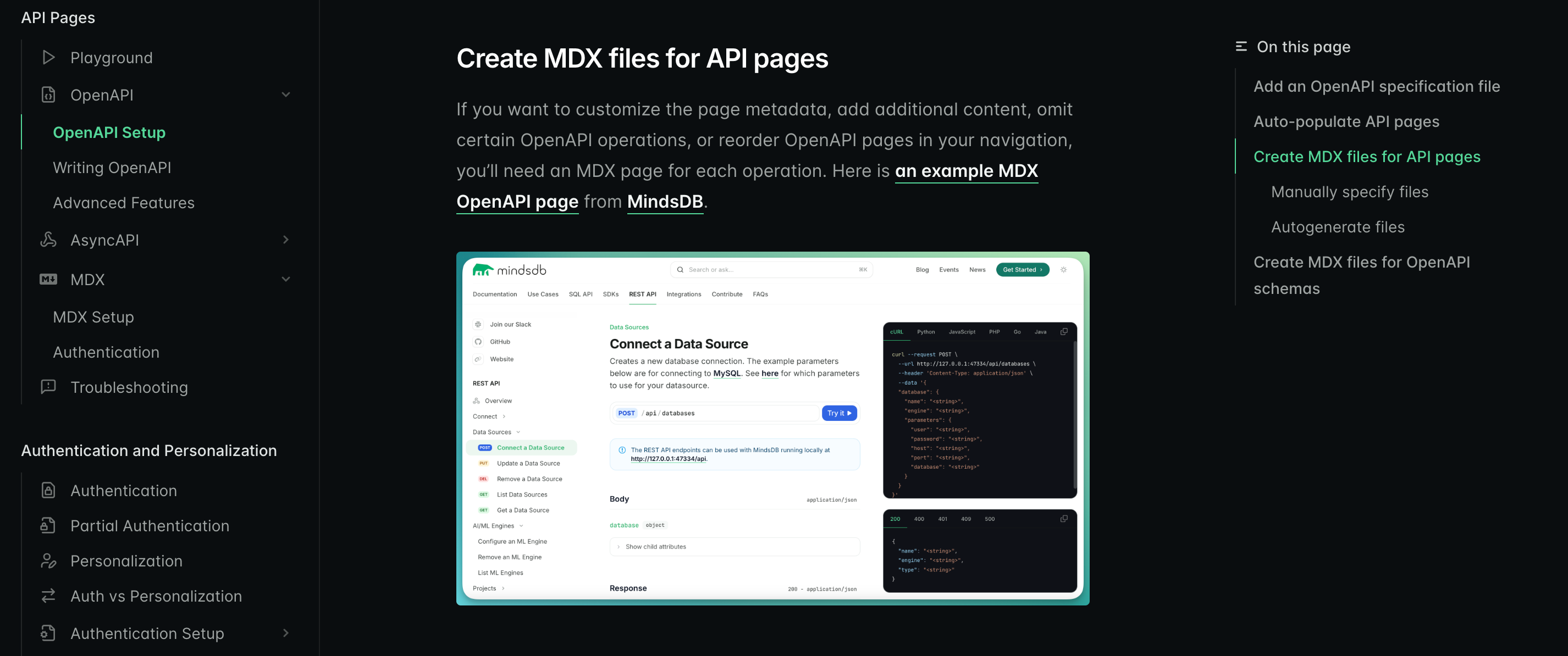
What makes it even better is the interactive API playground. You can test endpoints right inside the docs and get live responses, which makes everything easier to understand and faster to debug.
It also gives you real code examples in multiple languages, like cURL, Python, and JavaScript, so developers can easily get started. This makes your docs practical, not just pretty pages.
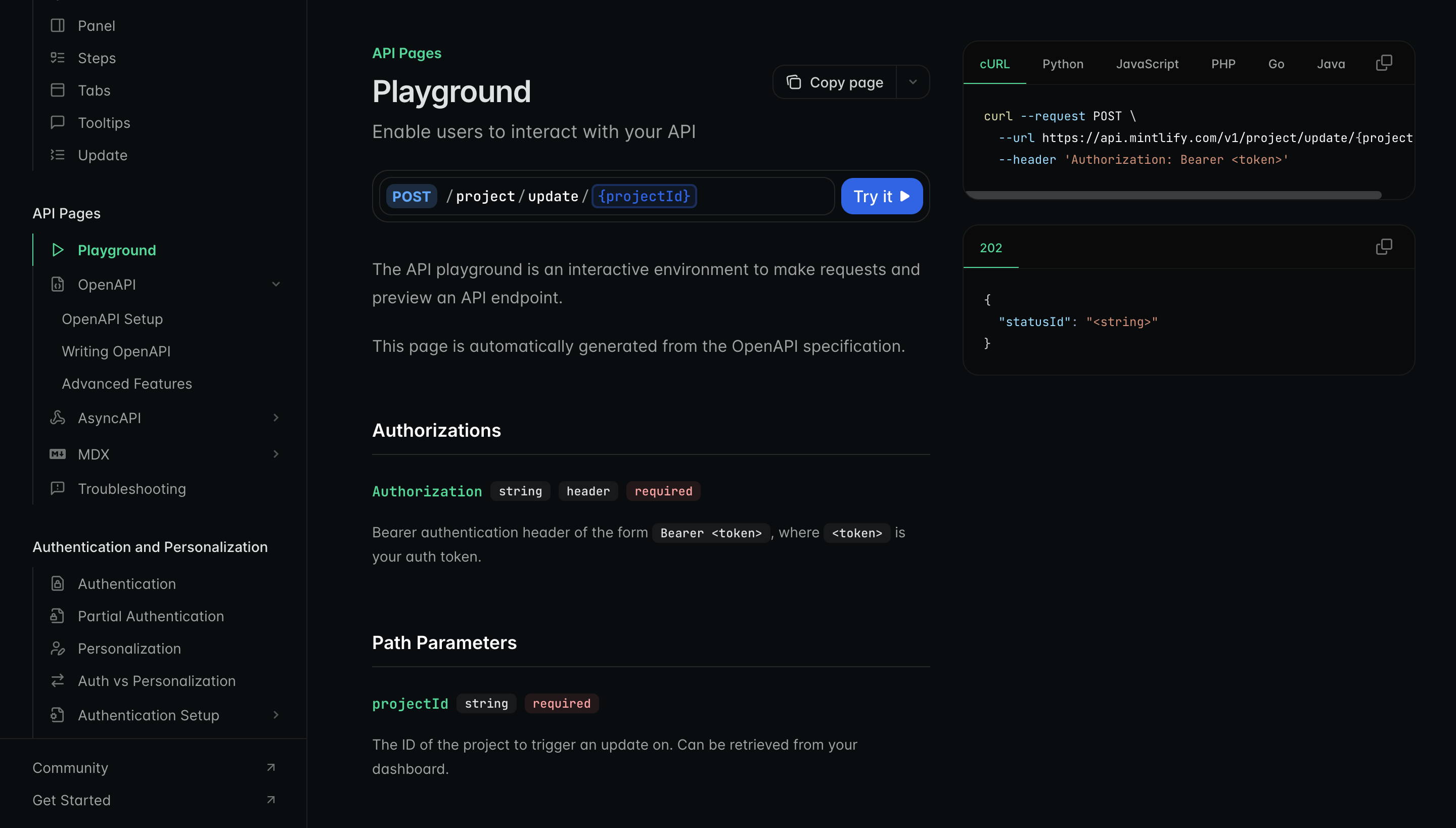
You also get a few smart extras, like built-in translation support, ideal if your products support other regions, and AI-powered search chat. This makes it easy to find specific endpoints quickly.
Drawbacks
Mintlify currently has fewer built-in collaboration features (i.e., comments, suggestions) compared to other tools like ReadMe or GitBook.
Workaround
You can use external tools like GitHub or Slack for team discussions and review, then update the Mintlify docs accordingly.
When to choose it
When engineers are the ones writing your docs, or you're aiming for speed and AI-readiness, Mintlify fits right in. It works with your existing dev process and gives you full control, so you can add walkthroughs, improve explanations, or bring in smart integrations that give both people and language models what they need to find answers quickly.
ReadMe
ReadMe is a developer documentation platform that highlights interactivity and responsive design. It brings everything together in one section: API references, changelogs, feedback, and even onboarding, all without bouncing between tools.

The developer platform dashboard brings together API references, changelogs, feedback, and onboarding tools for simple management.
Best suited for
ReadMe is well-suited for teams building public APIs. Its onboarding features help developers get started quickly, and the ability to test endpoints directly in the browser supports a hands-on learning experience.
To make implementation easier, ReadMe includes code samples in over 20 languages, offering clear examples without requiring additional setup.
What makes it stand out
Getting started with documentation is straightforward; you can upload OpenAPI files or Postman collections, and ReadMe will generate the documentation. It also includes a built-in Postman-to-OpenAPI converter, helping reduce manual conversion steps.
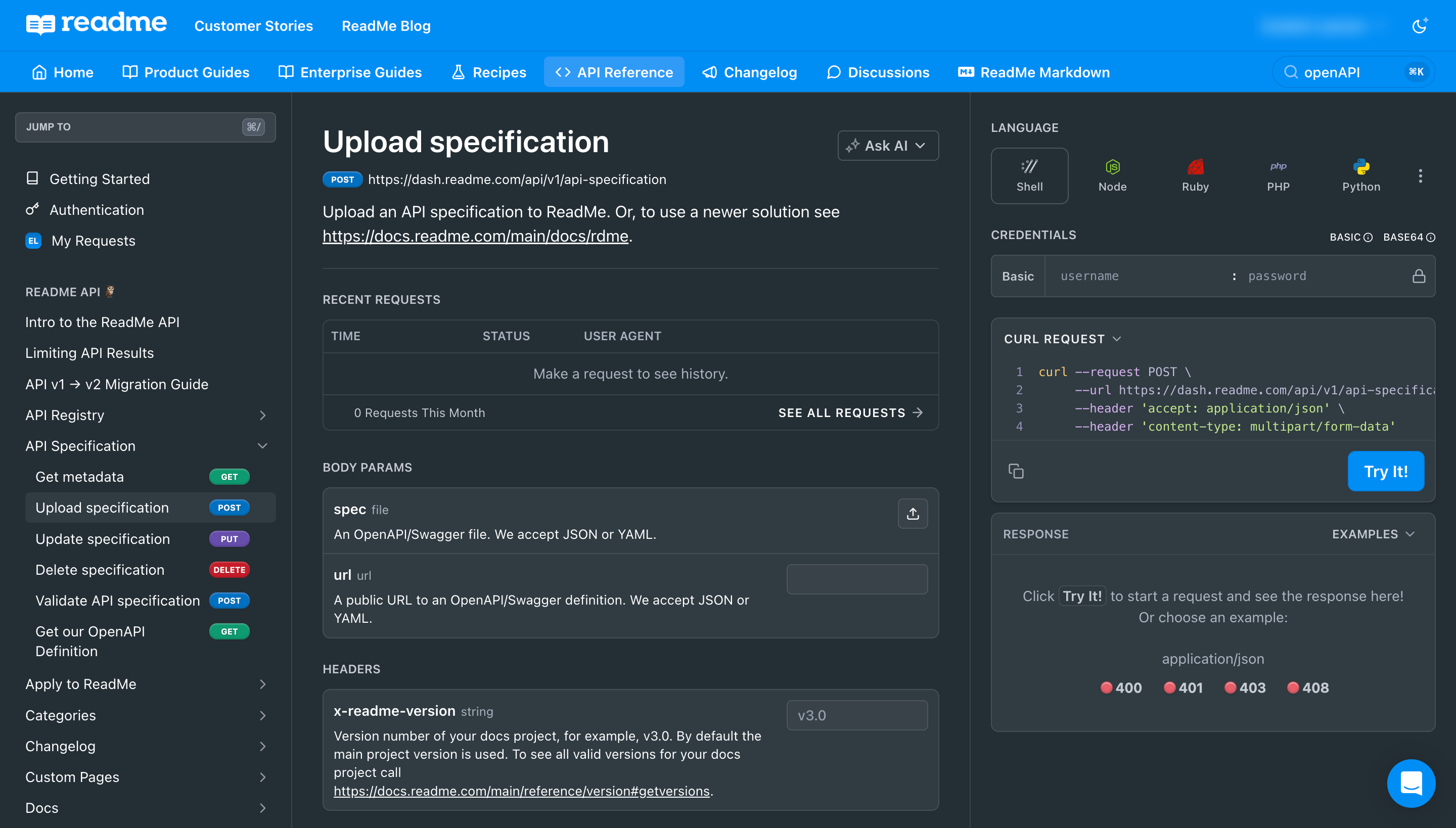
ReadMe makes it easy to spin up API docs, upload your OpenAPI files or Postman collections, and it handles the rest automatically.
The “Try it” playground lets developers test API endpoints in the browser and see responses in real time. It also generates code snippets automatically, which can help users better understand how to interact with the API.
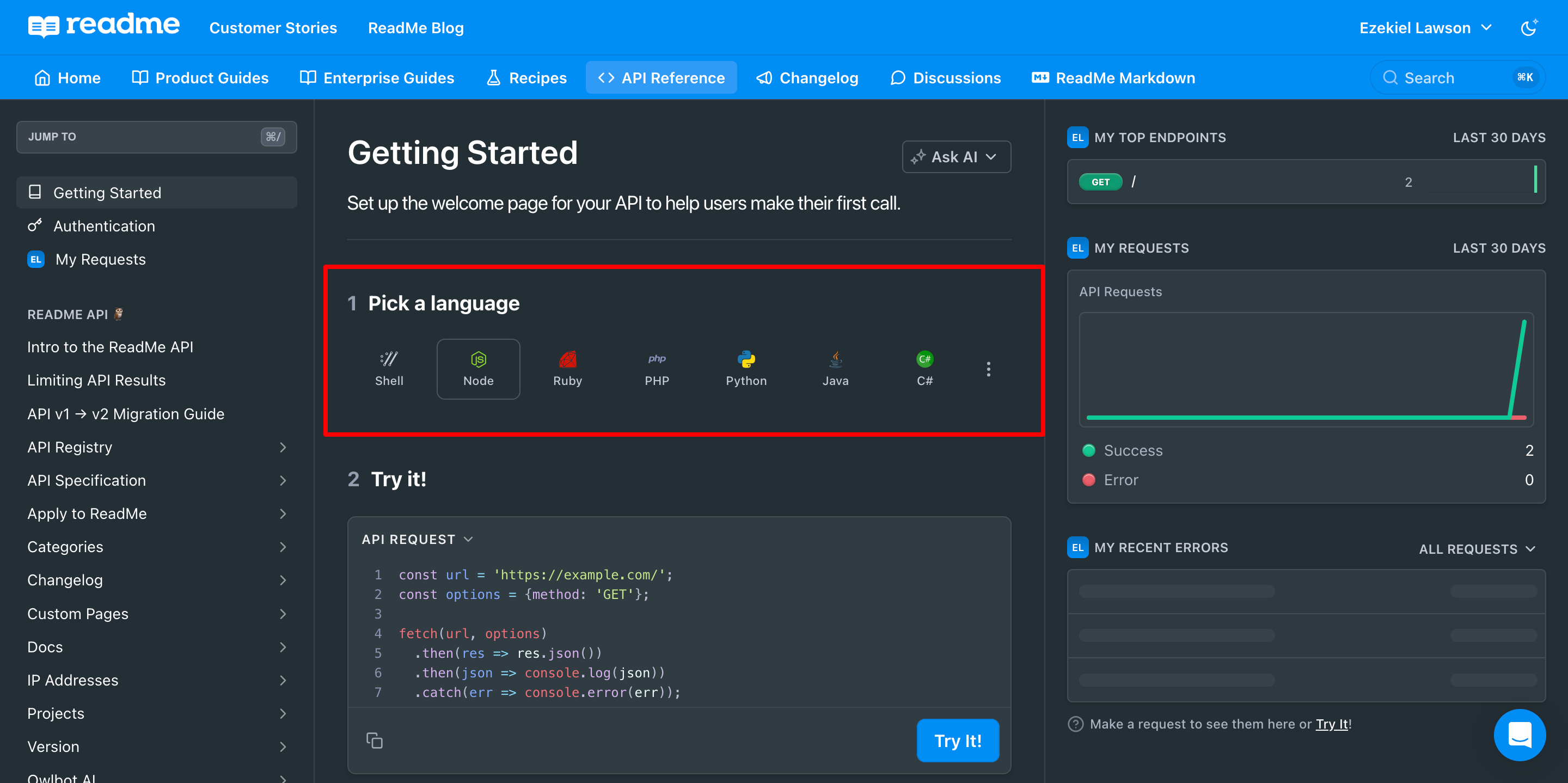
The “Try it” Playground allows developers to test APIs in the browser with real-time feedback and auto-generated code snippets for easier implementation.
Beyond onboarding and testing, ReadMe supports engagement through built-in forums and feedback tools. These features help teams stay aligned with user needs by capturing questions, suggestions, and bug reports directly within the docs.

The ReadMe platform includes built-in forums and feedback tools to improve developer collaboration.
ReadMe is created to accommodate contributions from across the organization, not just developers. It's simple visual editor allows non-technical users to make content updates, adjust styling, and manage layouts without writing any code.
To support smooth team collaboration, ReadMe also includes:
- A flexible editing interface for customizing text, visuals, and page structure
- Built-in tools for creating lightweight landing pages through the dashboard
Drawbacks
One issue with ReadMe is that it doesn't automatically update your docs when your OpenAPI spec changes. You have to upload each new version yourself, which means:
- Your docs can get out-of-date fast.
- There's no easy way to integrate it with your build or deployment process.
- Doing updates by hand can cause mistakes and slow things down.
People also complain about the limited formatting options. Adding images inside text or aligning things isn't straightforward; you usually need to mess with HTML or CSS, which can be a bit of a headache.
Workaround
You can set up some automation using ReadMe's API or CLI tools to push updates whenever you deploy. Using GitHub Actions or simple scripts can save you from having to do it all manually.
When to choose it
ReadMe is a good choice for non-technical teams that want full control over layouts and landing pages, without writing any code. It supports live tutorials, quick API spec imports, and built-in community forums that help boost engagement. Whether you're working on a B2B product or managing a platform-as-a-service, it provides the tools to create a connected and interactive documentation experience.
GitBook
GitBook gives you a friendly space where you can write, share, and organize documentation together. It's similar to Notion, but designed with developers in mind. Setting up is simple, and it provides a sample template to help you get started, making the learning curve much easier to handle.

GitBook sample template showing the basic steps to understanding an API.
Best suited for
GitBook is well-suited for non-technical documentation or writing long-form content like product guides or internal knowledge bases. It's good in systems where technical and non-technical team members contribute to documentation.
What makes it stand out
GitBook handles everything in one place, such as text, images, and code snippets. However, the most notable feature is Git Sync. It connects directly with GitHub and GitLab, so devs can push updates straight from their usual Git workflow, while writers can work comfortably in GitBook's editor.
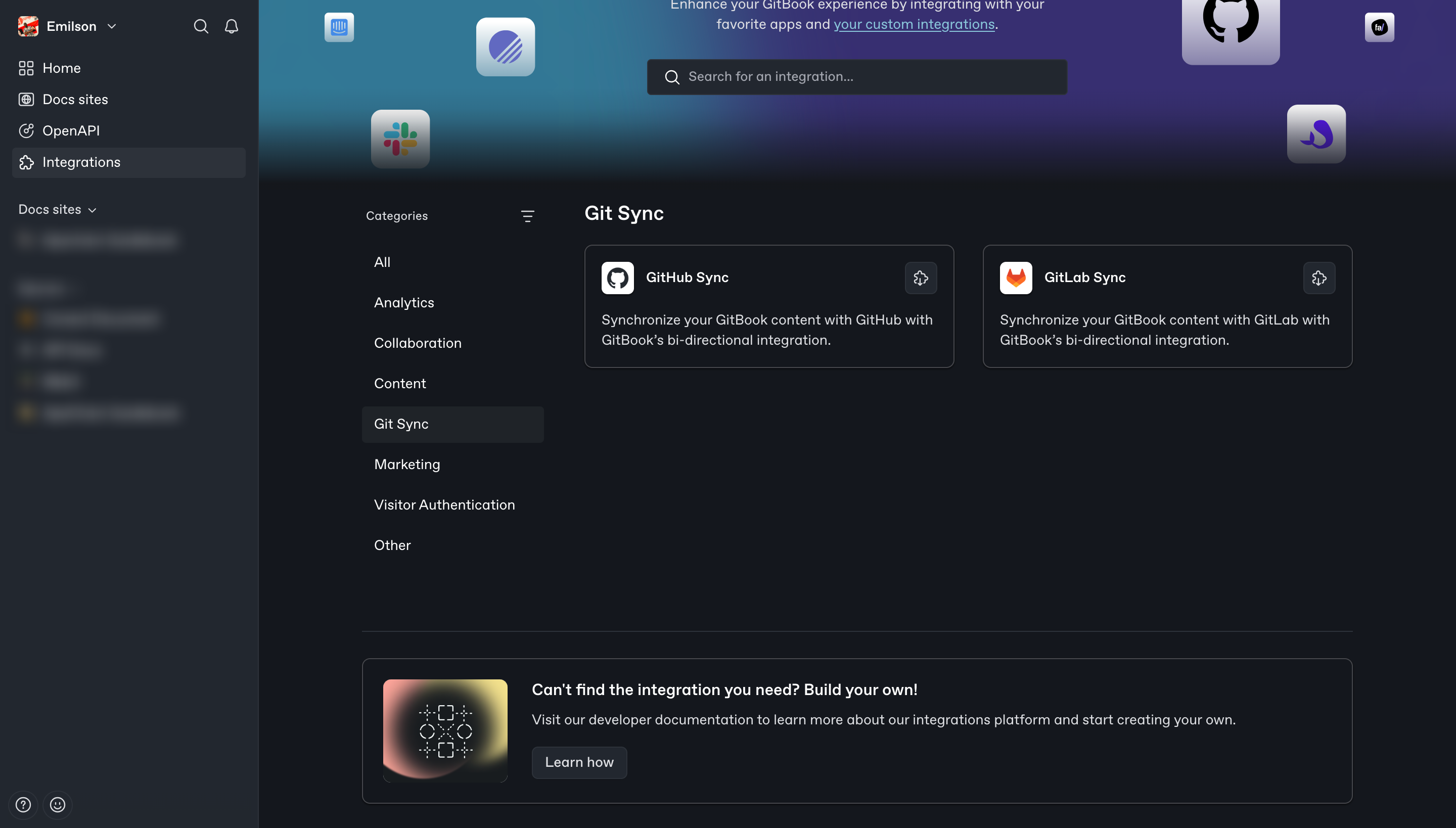
GitBook user friendly interface showing Git Sync integration with GitHub and GitLab for collaboration.
You can autogenerate API documentation by uploading an OpenAPI spec, but the output feels more basic compared to what Mintlify or ReadMe offers. It lacks the polished design, interactive features, and contextual guidance that make those tools stand out.
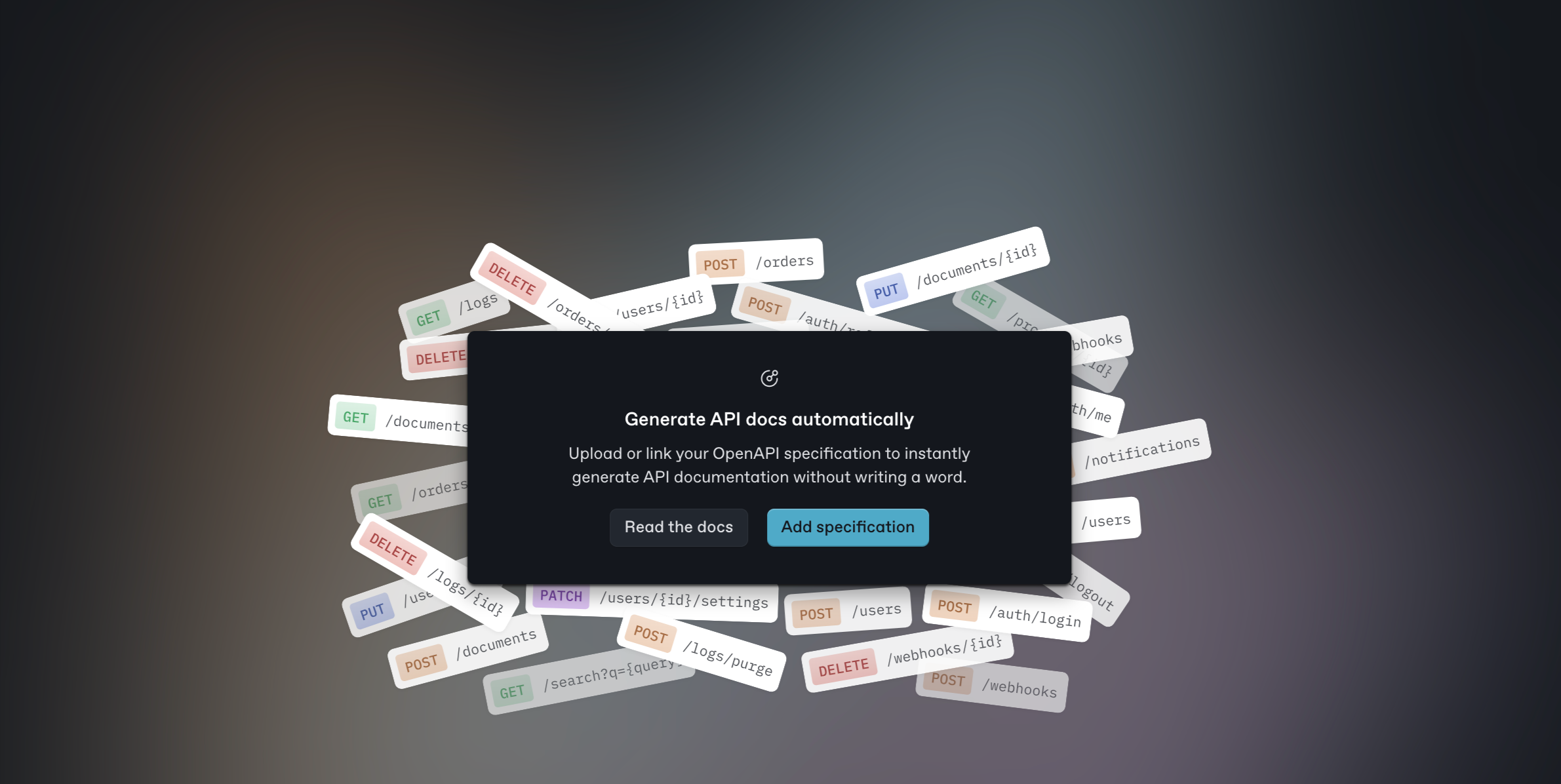
GitBook automatically generates API documentation from your OpenAPI specifications, providing a quick and structured way to present your endpoints
GitBook integrates with GitHub Copilot to deliver real-time answers from your documentation directly within your coding environment. It helps developers quickly access relevant information while working, whether setting up projects, debugging, or referencing internal guides.

GitBook Copilot delivers instant answers from your docs directly in your GitHub workflow, helping your team access knowledge easily.
For broader exploration, the Quick Find feature allows users to search across organization-wide docs and navigate between sections quickly. It adheres to your team's permission settings, allowing users to search only the content they are authorized to access.
GitBook supports real-time collaborative editing and includes a built-in commenting system for feedback within the documentation. Additionally, GitBook recently introduced GitBook AI, a feature that assists with content generation and editing to streamline the writing process.
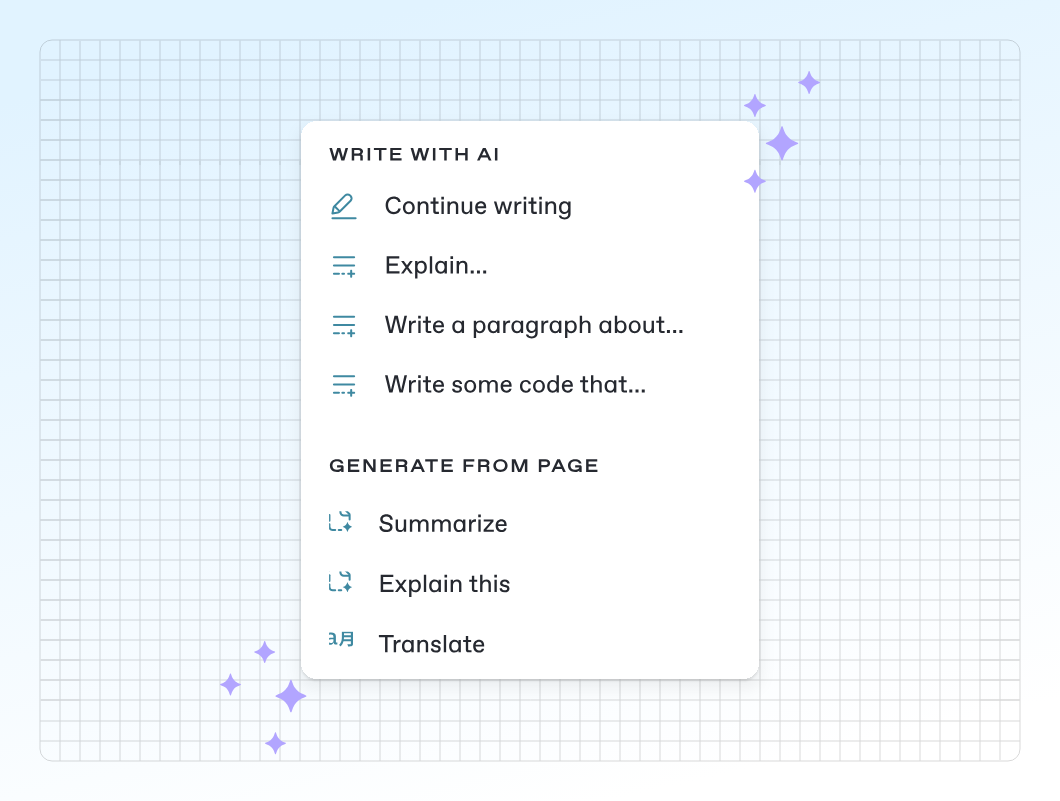
GitBook AI allows you to generate content directly within your docs, from summaries and templates to code samples, all formatted in Markdown.
Drawbacks
GitBook is not built for heavy API customization. The auto-generated API docs are solid but lack the polish of Mintlify or ReadMe's interactive features. It can also get pricey for larger teams, and the Git Sync can be tricky to set up if your repository is disorganized.
When to choose it
Do you need documents that anyone can edit, requiring no tech skills? GitBook is the way to go. It works well for SaaS teams and internal documentation. If you're building a product that doesn't rely much on code samples but still needs clear, collaborative documentation, GitBook is the best option to get started with.
Docusaurus
Docusaurus is an open source documentation site generator created by Meta to build, manage, and publish interactive documentation. It's popular for product and technical docs because it's easy to set up and maintain.
Best suited for
Docusaurus shines when you want maximum flexibility and don't mind managing your docs as code. It makes handling things like multi-versioning, search, blog integration, and syntax highlighting feel smooth and powerful.
What makes it stand out
Docusaurus supports both Markdown and MDX, offering flexibility for different teams. Markdown provides a straightforward way for non-technical users to create content, while MDX allows developers to extend functionality and customize documentation as needed.
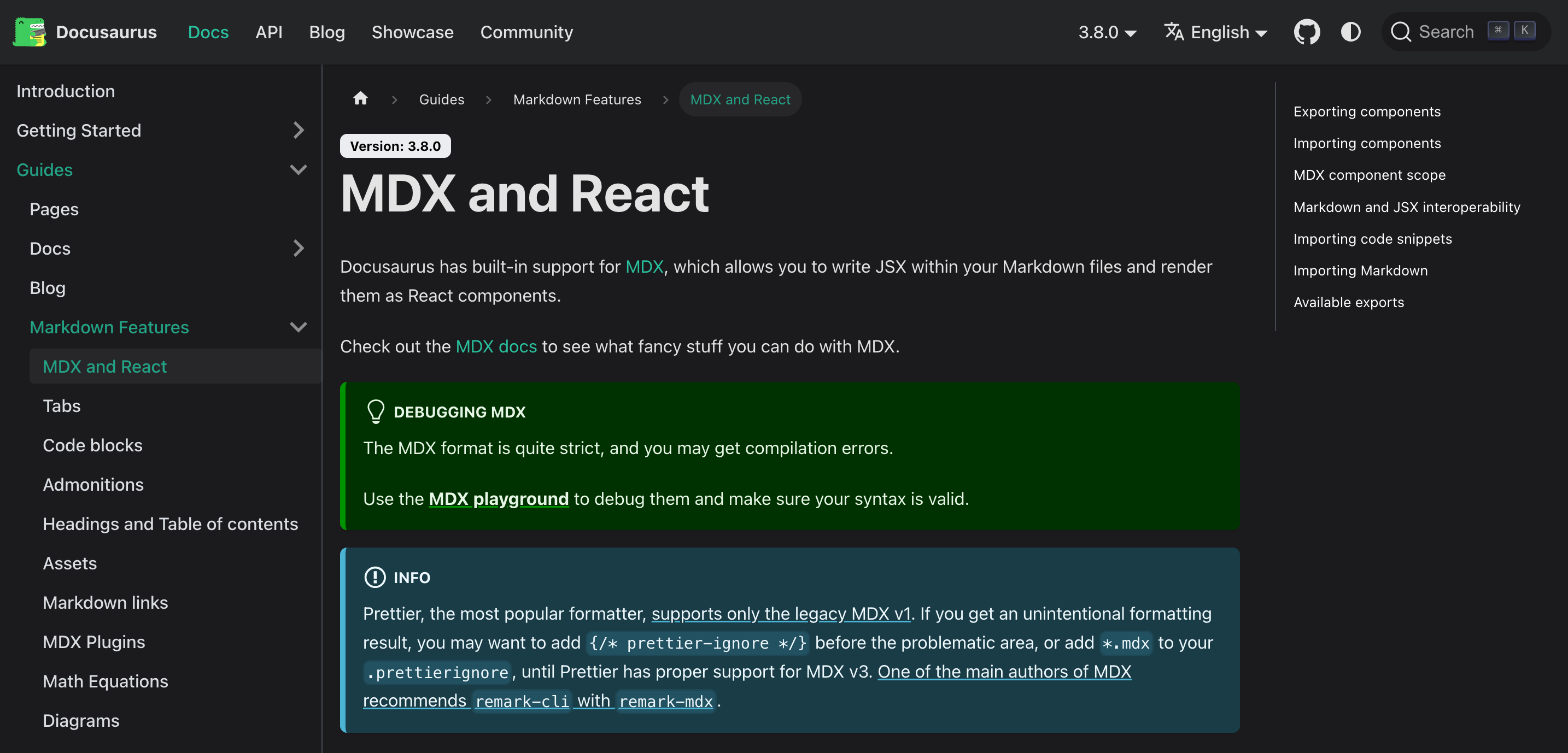
Docusaurus's Markdown and MDX support lets you balance simplicity and power, but you will need dev skills to unlock its full potential
Docusaurus offers easy integration with multiple search tools, including Algolia DocSearch for fast, full-text search out of the box. You can also configure alternative options like Typesense, local search, or build a custom search bar to match your needs.
Versioning is another practical feature in Docusaurus. It enables you to manage and publish multiple versions of your documentation, helping users access the right information for each release.
For teams with international users, Docusaurus includes built-in internationalization support, making it possible to translate and maintain documentation in multiple languages.

Docusaurus interface displaying multilingual documentation with built-in i18n support.
Docusaurus v2 uses the PRPL pattern—Push, Render, Pre-cache, Lazy-load; a modern web performance approach that helps reduce load times and improve interactivity by delivering content progressively.
While the result can be fast documentation sites, performance depends on implementation, hosting, and build optimizations.
Drawbacks and workarounds
If you plan to work with Docusaurus, you need a good developer experience, as the setup can be tedious, especially when using React or Node.js. Aside from that, it doesn't have a built-in interactive console like Mintlify or ReadMe, but you can add one with plugins like Redoc. It's also too complex for non-technical teams or simple sites.
When to choose it
Choose Docusaurus when complete control isn't optional. Built for people who know and love React, it's the go-to solution for open-source projects and high-performance sites that demand complete customization. If you want to build it your way, there's no better choice.
2. API reference generators
These tools focus on one main job: turning your OpenAPI (or Swagger) specs into clear, easy-to-use reference docs. They don't build full documentation sites but do a great job helping users explore and understand your APIs.

Swagger UI
Swagger UI is a widely used open-source interface for visualizing and interacting with OpenAPI specifications. Maintained by SmartBear, it lets developers and other users explore RESTful APIs directly in the browser.
Best suited for
Swagger UI renders API endpoints into a browsable, interactive web UI. It creates a testable interface where users input parameters and view responses without leaving the page.
What makes it stand out
Swagger UI takes your OpenAPI spec (JSON or YAML) and generates a clean, organized interface with all your endpoints, HTTP methods, and examples.
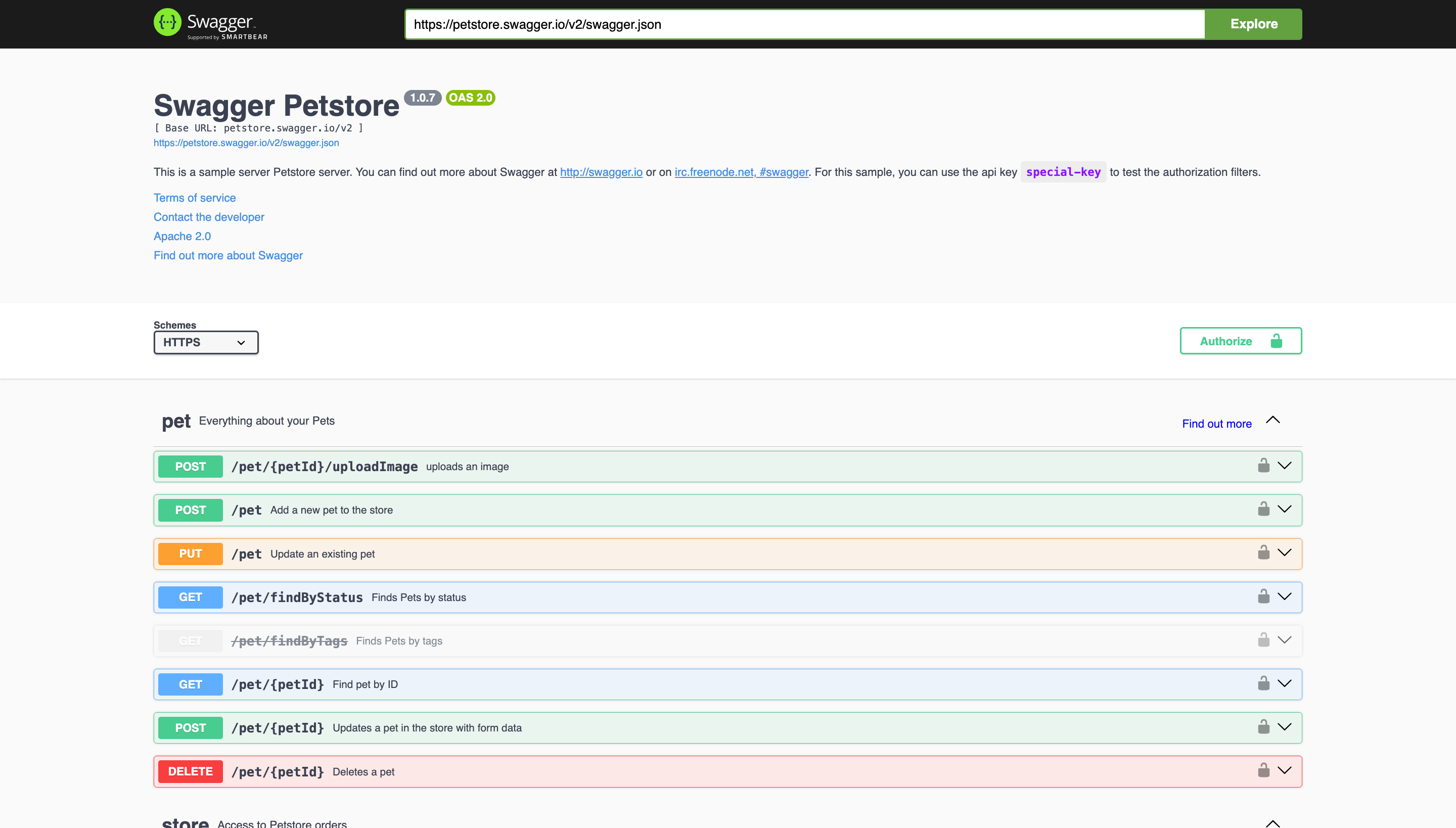
Swagger UI generating API documentation from OpenAPI specs with various HTTP methods.
The “Try it out” feature is a lifesaver; you can plug in parameters, hit send, and see real-time responses with status codes right in the browser. It's a huge time-saver for debugging or showing off your API.
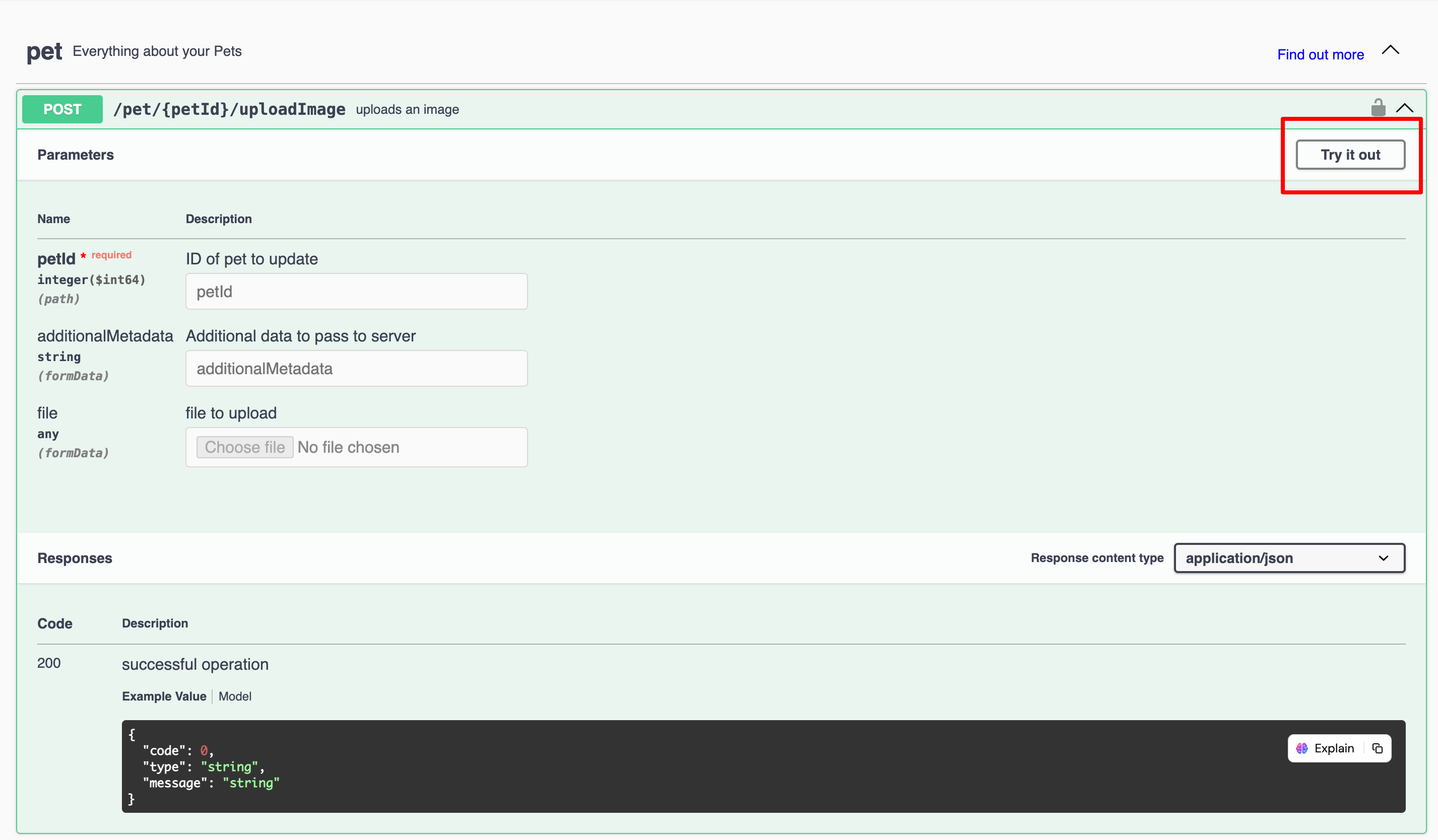
Swagger UI API ‘Try it out' feature allows testing endpoints with real-time responses in browser.
Getting started with Swagger UI is smooth, and the setup saves time. With a large developer community, it feels reliable and well-supported. It fits right into CI/CD workflows, so API docs update automatically without extra effort.
It's not a full doc site, but for solid API reference docs, it gets the job done. The free plan makes it a smart way to avoid the cost and complexity of tools like SwaggerHub.
Drawbacks
- Swagger UI focuses strictly on API specs and doesn't support creating guides, changelogs, or advanced versioning features.
- Some header names can't be controlled by web applications because of security restrictions built into web browsers.
- It lacks Git integration and doesn't support Markdown content.
Workaround
- You can pair Swagger UI with a static site generator like Docusaurus to build a full-featured documentation site.
When to choose it
Swagger UI is the best tool for publishing your OpenAPI specs. Want to share and test APIs super fast? This is the only tool you need, no setup, no headaches. For quick previews and easy sharing within your team, Swagger UI gets it done.
Redoc
Redoc is a top open-source tool for API docs. Made by Redocly, it turns OpenAPI specs into simple, fast-loading, responsive single-page apps. It's perfect when you want docs that look great and load quickly.
Best suited for
Redoc is built for teams who need a clean, readable API reference that scales. It's great for public APIs or developer portals where first impressions count, especially when presenting your product to potential partners or large organizations.
What makes it stand out
Redoc's three-panel layout is a thing of beauty: endpoints on the left, details in the middle, and sample requests on the right. It makes complex APIs easy to understand for newbies and pros.
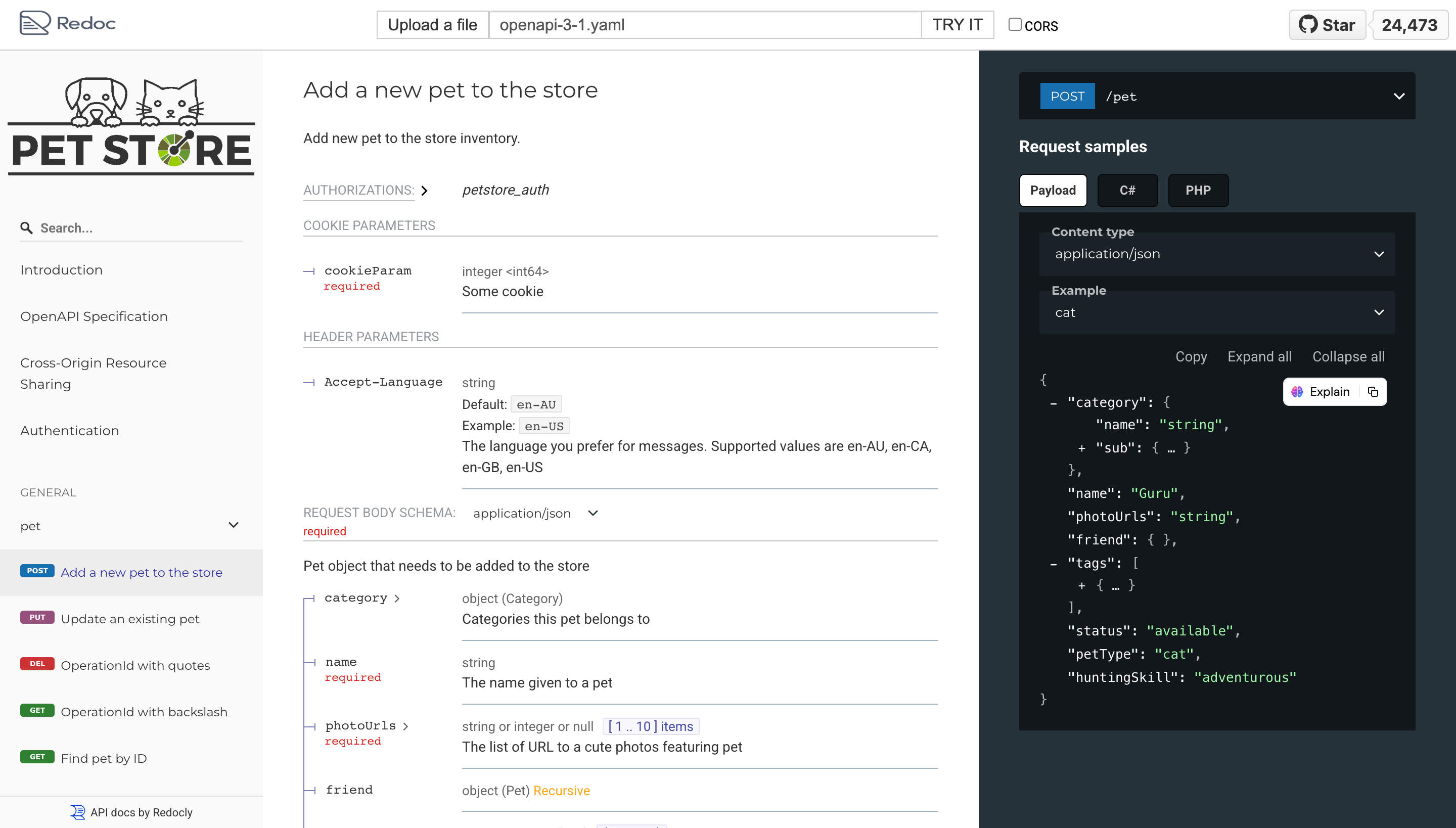
Redoc's three-panel layout presents interactive API documentation in a clear and organized way
Performance is a big plus with Redoc. Since it skips heavy JavaScript frameworks, your docs load super fast. You can try it out yourself by uploading your spec to Redocly's live demo.
I have used this feature to preview documentation before deployment. Additionally, it supports deep linking and Markdown descriptions, so users can jump straight to the parts they want.
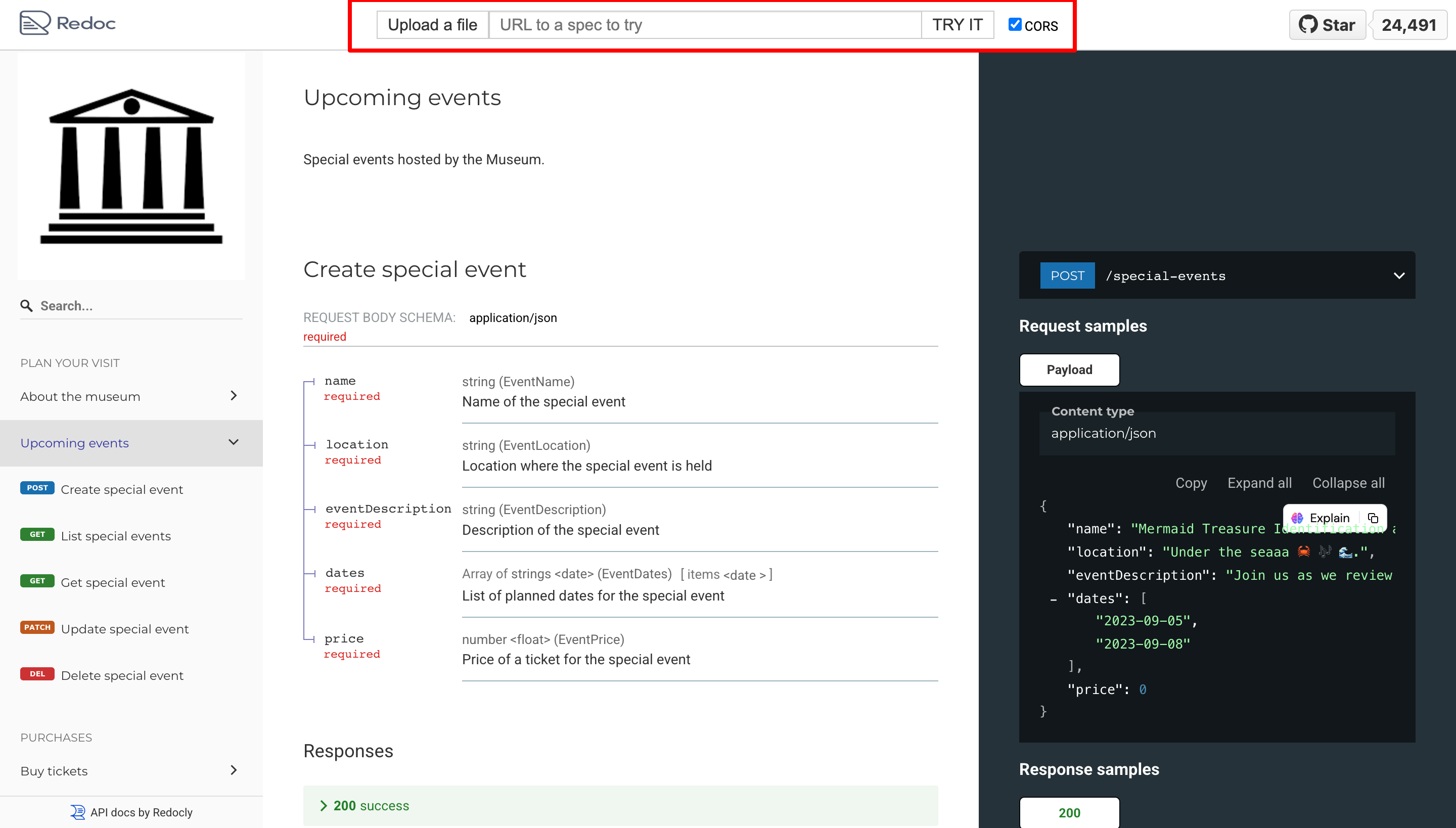
Redoc interface for uploading API specifications with ease and clarity.
Drawbacks
- Redoc doesn't have an interactive console to test endpoints directly like Swagger UI.
- Customization in Redoc is limited and slow; it often requires a deep dive into its source code.
Workaround
- If you need API interactivity, you will have to pair it with another tool, like Docusaurus + Swagger UI using the @redocly/openapi-cli.
- For customization, you can adjust colors and fonts using Redoc's theme settings with a simple JSON config.
When to choose it
If you need fast, reliable, and visually polished API documentation process with minimal setup, Redoc sets the standard. It turns your OpenAPI spec into beautiful, responsive docs without locking you into any specific vendor. For teams focused on performance and simplicity over interactive testing, Redoc is a game-changer.
Stoplight
Stoplight is an API design and documentation platform that makes managing API workflows way easier. Instead of juggling a bunch of different tools to design, test, and document your APIs, it brings everything together in one spot.
Best suited for
With Stoplight, you can integrate API references into existing websites or documentation frameworks. It provides a more customizable and developer-friendly alternative to Swagger UI and Redoc, especially for internal API portals.
What makes it stand out
You can visually design APIs without writing raw YAML and create mock servers to test endpoints before any code is written.
One thing that stands out is how it keeps your APIs in check with built-in style guides. It helps teams stick to consistent rules, like naming conventions or security standards, which reduces errors and eliminates the need to enforce them manually.
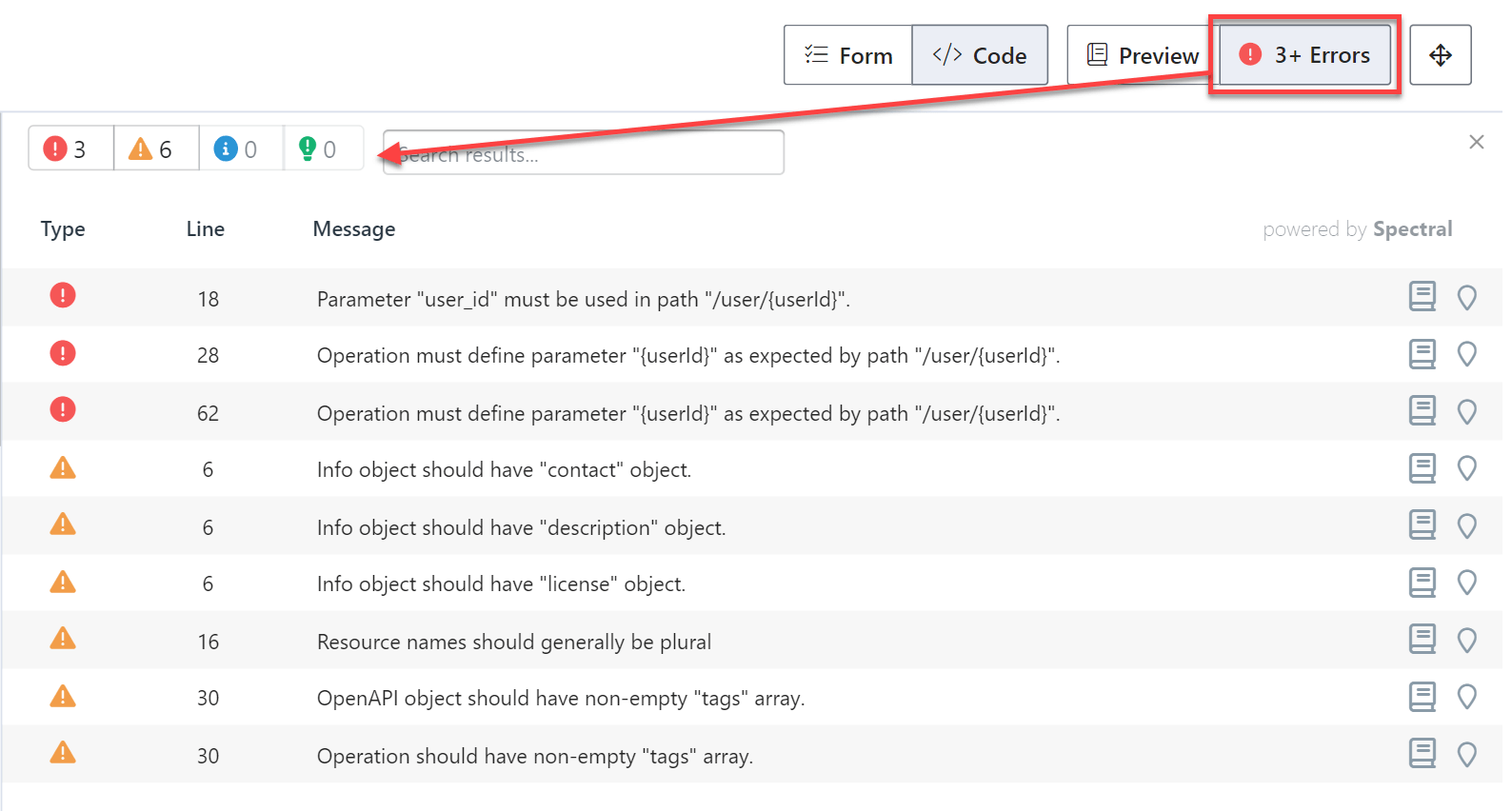
Stoplight's style guide ensures consistent API design across teams and projects
It's got everything you need: an API explorer, auto mock servers, a simple OpenAPI designer, an API console, and code samples in various languages.
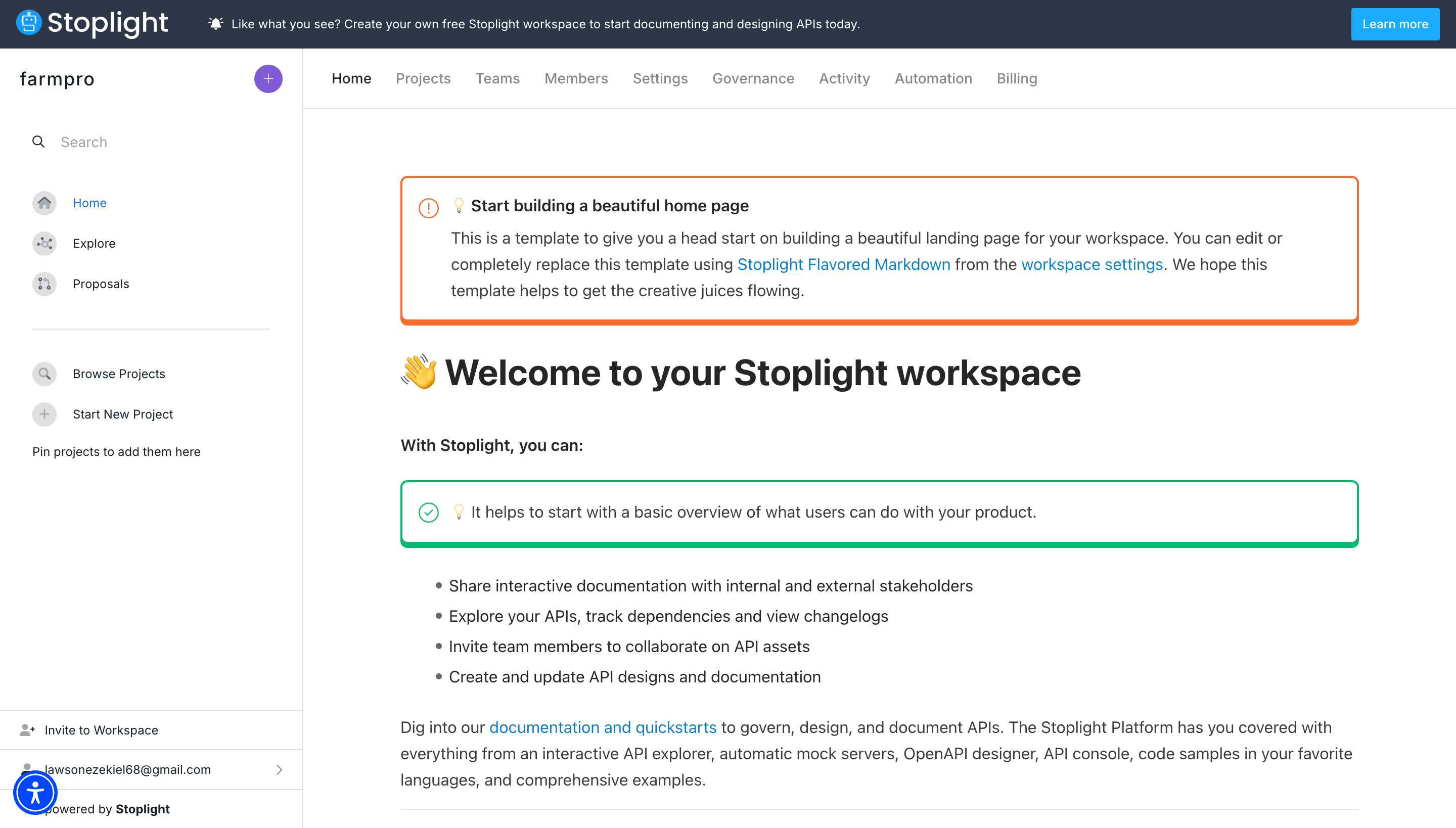
Stoplight's workspace dashboard centralizes API management for better organization and control.
You can create Getting Started guides right in Studio, import your Markdown docs, or connect Git repos with OpenAPI specs, JSON Schemas, and Markdown, all organized within your workspace.
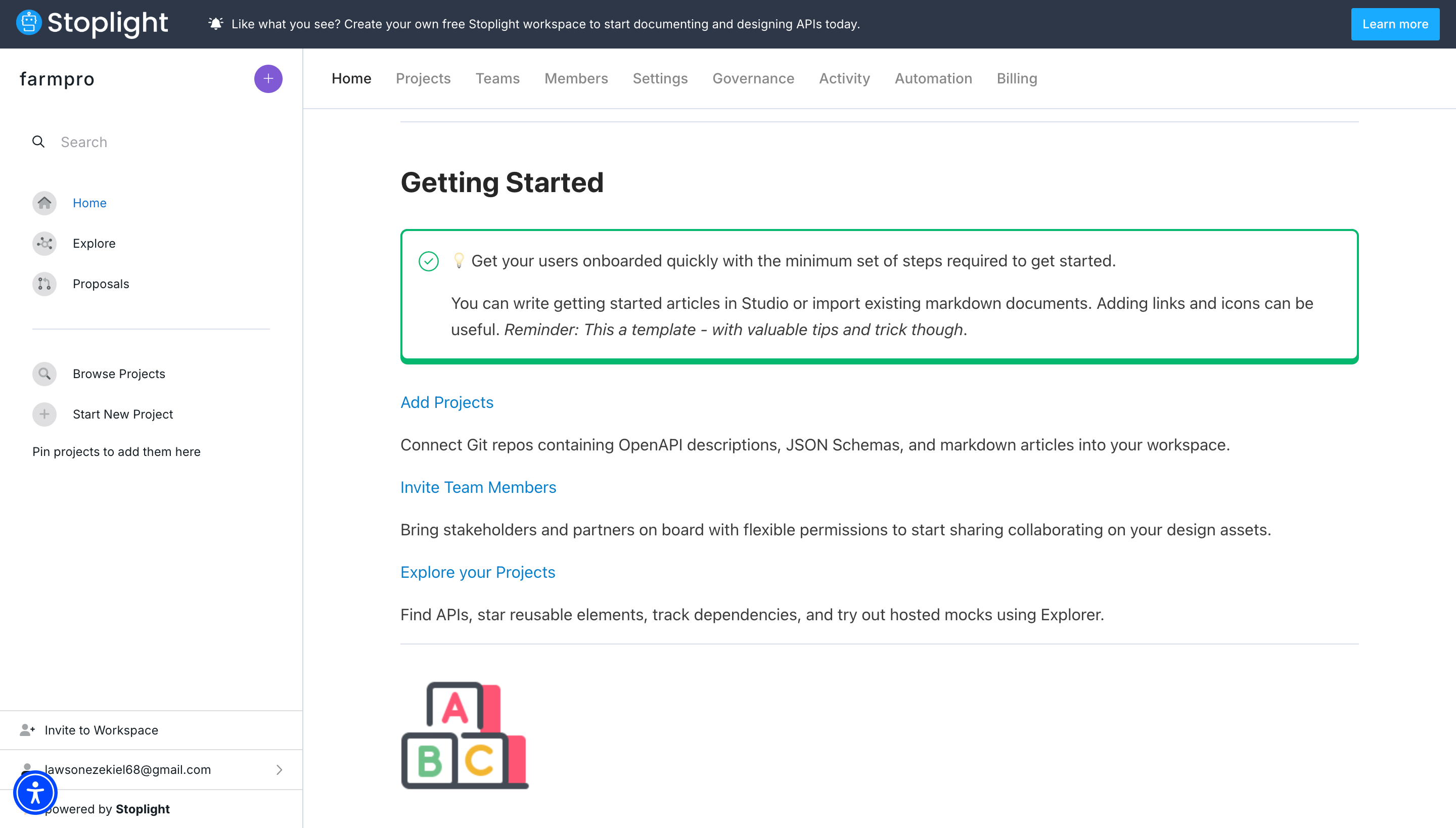
Stoplight's Studio lets you design and document APIs visually, keeping everyone aligned without drowning in YAML.
Additionally, it connects to platforms like AWS, Azure, and Kong, so moving from planning to deployment feels smooth and nothing slips through the gaps.
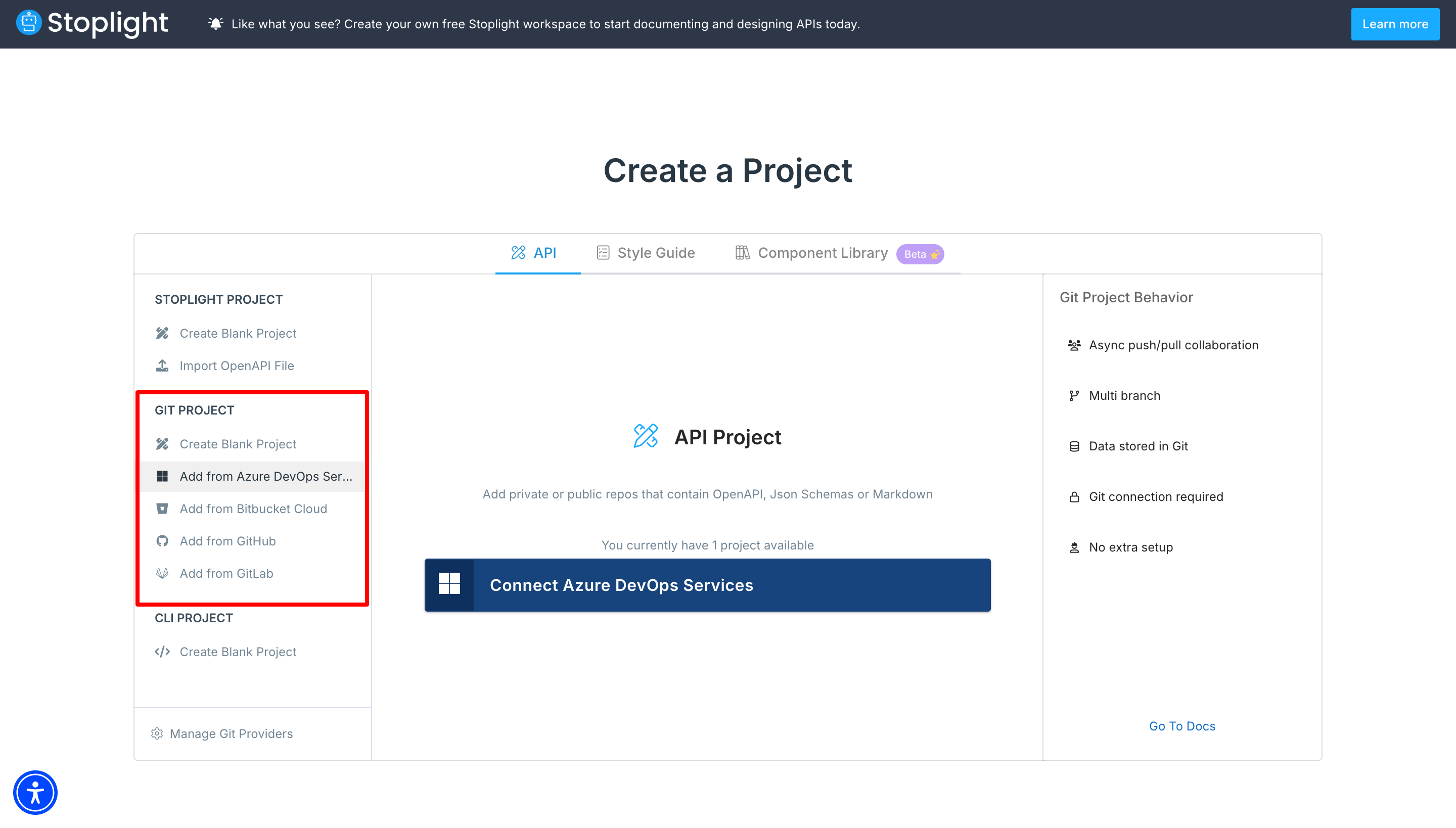
Stoplight's platform highlights simple integration options and customizable settings for smoother API workflows.
Drawbacks
- Stoplight's paid plans can be a bit much if you're a solo dev or running a small project.
- Things can get slow if you're working with a huge OpenAPI file.
Workaround
- As a solo dev, you can keep things simple by using the free Studio version and pairing it with Redoc for docs and Postman for testing.
- I once experienced a performance issue where things started slowing down. I fixed it by breaking the API into smaller sections using Stoplight's reference feature. It speeds things up and makes the whole thing easier to manage, just as their documentation suggests.
When to choose it
If you're building APIs and want everything, from designing to testing to docs, in one clean and easy setup, Stoplight is hands-down the best option. It makes the whole process smooth, especially if you have teammates who aren't into messing with raw YAML.
SwaggerHub
SwaggerHub is a cloud-based API design and documentation platform from SmartBear that I have found really useful for team collaboration. It allows you to centralize hosting, editing, and documenting your OpenAPI specs all in one place, which keeps everyone on the same page.
Best suited for
If you need a solid, integrated system to manage OpenAPI specs, publish clear reference docs, and keep consistency across services, SwaggerHub is a strong fit, especially if you're working in a regulated environment or a large enterprise.
What makes it stand out
What really stands out with SwaggerHub is how it brings everything you need into one cloud-based platform. From creating and validating specs to managing documentation, version control, and hosting, it's all built in. Plus, the team management, access controls, and publishing environments mean you won't have to waste time building custom pipelines.

SwaggerHub's API dashboard provides a clear overview of key features, helping teams manage and collaborate on APIs.
You can start with the free version to understand the platform, and when you need advanced collaboration and versioning features, upgrading is simple. Trust me, it makes managing your API lifecycle way easier.
Drawbacks
- SwaggerHub can get expensive quickly, especially if you're on a small team or working on a startup project. The free plan covers basic needs, but costs rise fast as you scale.
- You might also find the interface a bit slow at times, particularly when handling large specs. Tools like Redoc tend to run much faster.
Workarounds
- If you're looking for a free alternative, Swagger UI is a solid option. You can run it locally and sync your specs with Git. It's a simple setup that works well for small teams.
- If the interface feels sluggish, try using the SwaggerHub CLI. It speeds up uploading and validating specs without relying on the browser.
When to choose it
Use SwaggerHub if you want an all-in-one platform that handles every stage of your API lifecycle effortlessly. If you're serious about CI/CD and need powerful built-in mocking and testing to catch problems before they hit production, SwaggerHub is the best tool to get it done, no exceptions.
3. API tools with embedded documentation support
This category is all about platforms that do more than just testing. They help you design, debug, document, and share APIs all in one place. These tools bring everything together so your team can collaborate without juggling separate apps for specs, testing, and docs.

I have found Postman to be one of the easiest and popular tool for building, testing, and documenting APIs. It's great for API developers and teams who want everything—design, testing, and docs, all in one place.
Best suited for
If you want to manage your entire API lifecycle without juggling multiple tools, Postman has you covered. It supports HTTP, GraphQL, gRPC, WebSocket, and more, plus smooth collaboration and source control for teams.
What makes it stand out
Getting started is easy: you can import APIs from cURL commands, files, or URLs in just a few clicks. Sending sample requests and testing is quick and intuitive.
What really sets it apart is how your documentation stays live; any changes to your requests are automatically updated in your docs, which you can publish instantly. Plus, it integrates well with Slack, GitHub, and CI/CD pipelines, keeping your team in sync.

Postman's API testing interface offers a user-friendly guide to streamline and simplify the testing process.
Postman keeps everything connected. Your docs stay updated automatically because they're directly linked to your request collections. You can document endpoints, parameters, and example responses right where you build and test them, then instantly publish to a public or private URL, without any extra steps.

Postman's platform highlights important features created to support and accelerate API development.
Drawbacks
- Postman's free plan limits collaboration features and API call quotas, which can be a challenge for larger teams.
- The desktop app can also be resource-heavy, especially on older machines.
Workarounds
- For smaller projects, the free tier works well. I have paired it with tools like Insomnia to stay within limits and handle additional testing without issues.
- If performance is a concern, the web version is a solid alternative. I have run it on a low-spec laptop and found it much smoother compared to the desktop app.
When to choose it
Postman is a strong option if you want a unified platform for building, testing, and sharing API docs. It's perfect for public APIs or teams that need tight integration options with their development workflow.
Insomnia
Insomnia is a modern API client that supports REST, GraphQL, and gRPC. It focuses on API testing and debugging but includes built-in support for automatic generation from collections and environment data.
Best suited for
Insomnia is a solid choice if you want a simple, fast tool to test and work with APIs like REST, GraphQL, gRPC, and WebSocket. It's lightweight, works on any platform, and has all the basics you need, like environment variables, authentication, mocking, automated testing, and some easy documentation.
What makes it stand out
Insomnia's clean interface feels refreshing. It handles multiple API protocols with ease, and the built-in documentation auto-generates from your collections and environment variables.
I love how it syncs with Git for version control, keeping my work backed up without extra work.
The plugin system lets you add only the features you need, keeping things lean.
Encrypted team sync is a big plus for collaboration, and the spec validation catches errors early, saving you from late-night debugging sessions.
Need more features? You can add extra tools through its plugin system, with hundreds to choose from. This helps you keep your setup light and only use what you need.
Drawbacks
- Insomnia's docs get the job done, but they're pretty basic compared to what you get with Postman or Stoplight.
- It's not built for complex API hubs or sharing with non-tech folks. The plugin system is a nice bonus, but it's not as deep as Postman's, so you might find yourself missing some of the more advanced features and integrations.
Workaround
- If you need better docs or better sharing options, consider combining Insomnia with a dedicated docs tool like Stoplight or Redoc for a more complete setup.
When to choose it
Insomnia is the only tool when speed and simplicity matter more than enterprise overhead. It's purpose-built for developers and small teams who need a lightweight, high-performance client that works easily across different API protocols.
4. Static site generators for docs-as-code workflows
This section highlights an open-source documentation tool that gives you complete control over how your docs look and function. While it requires more setup and ongoing maintenance, it is typically handled by your technical team. It's a great option if you want maximum flexibility without being tied to a hosted platform.
MkDocs
MkDocs is a lightweight, open source static site generator written in Python and powered by Markdown. It's widely adopted in the open-source and devtool community.

MkDocs highlights key features with configuration options and live preview tools for documentation.
Best suited for
MkDocs makes converting Markdown files into a static website straightforward and quick. It handles different versions well.
What makes it stand out
MkDocs is all about simplicity. You write clean .md files, configure everything with a single mkdocs.yml, and get a polished site without tussling with JavaScript frameworks.
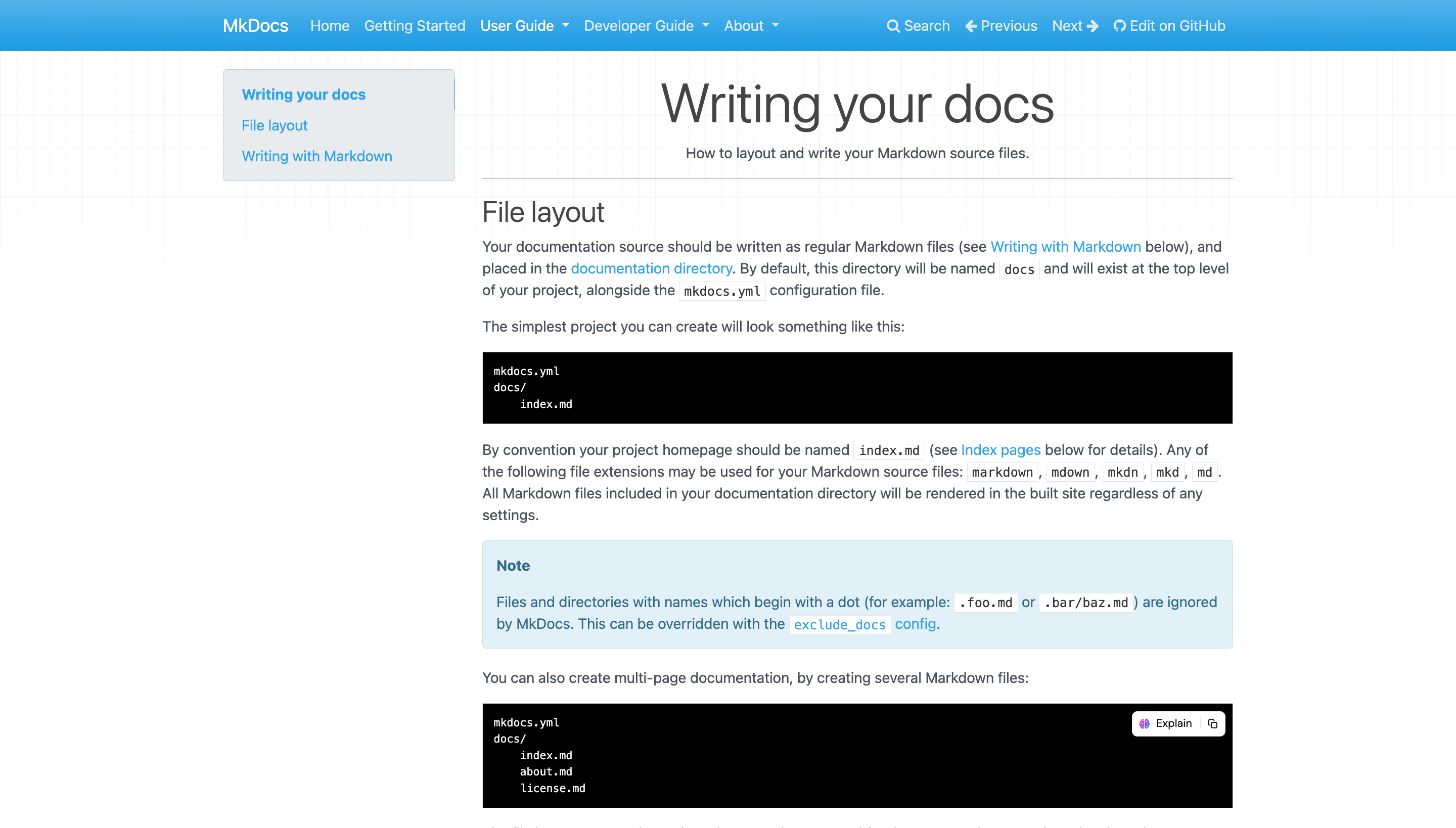
MkDocs setup combines clean Markdown with straightforward YAML configuration for easy customization.
It has a live-reload server, so you can see changes instantly. It also pulls docs straight from code docstrings, which keeps everything up to date without extra work. Integrating with CI/CD pipelines is smooth, making automation simple.
If you work a lot with Python, it feels especially natural. And when it's time to publish, pushing to GitHub Pages, Netlify, or AWS S3 is easy.
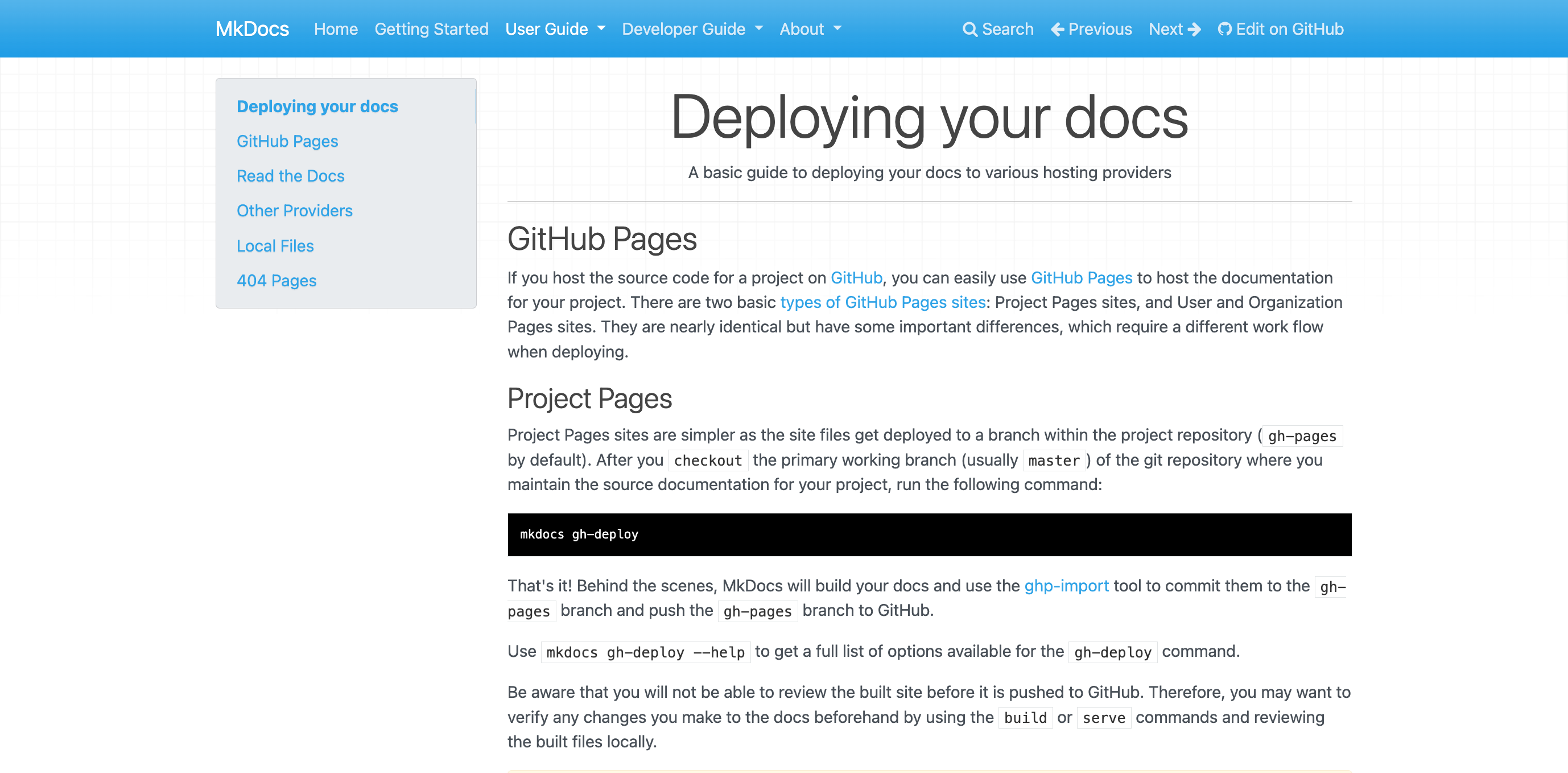
MkDocs allows for easy deployment to platforms like GitHub Pages or Netlify, making the process of publishing interactive documentation seamless
Drawbacks
- MkDocs is a static site generator, so it doesn't support built-in API testing or interactive consoles.
- Customizing MkDocs at a deeper level, like creating plugins, does require Python knowledge, which can be a challenge for non-developers.
Workaround
- You can embed Swagger UI into your MkDocs site to add interactive elements. I have used the mkdocs-swagger-ui-tag plugin to integrate live API docs, and it worked smoothly.
- For most visual customization, you don't need to touch Python. I have used the Material for MkDocs theme, which lets you tweak the design using YAML settings. With that alone, you can match a client's branding without writing a single line of Python.
When to choose it
If your team works primarily in Markdown and needs a fast, straightforward docs-as-code workflow, MkDocs is the clear choice, no question. It's lightweight, integrates easily with GitHub, and stays out of your way so you can focus on writing. For technical teams that value speed, version control, and simplicity, nothing comes close.
Final Thoughts
The best API documentation tool for your team depends on how you build, maintain, and scale your product. Start by identifying your team's top priorities:
- Do you need docs that update automatically with every schema change?
- Are you managing multiple versions or large teams with parallel workstreams?
- Is fast onboarding or LLM-readiness a core part of your developer experience?
- Do you want a docs-as-code approach or a fully hosted platform?
Use these questions to guide your decision.
If you're looking for a platform that balances performance, ease of use, and thoughtful features, Mintlify was built for that. It combines essentials like OpenAPI support, collaboration, and version control with modern essentials like AI-assisted writing, advanced analytics, and LLM-optimized formatting, all with minimal engineering resources required.
We built Mintlify for teams who want to create beautiful documentation and move quickly. If that sounds like you, it's a strong place to start.
More blog posts to read
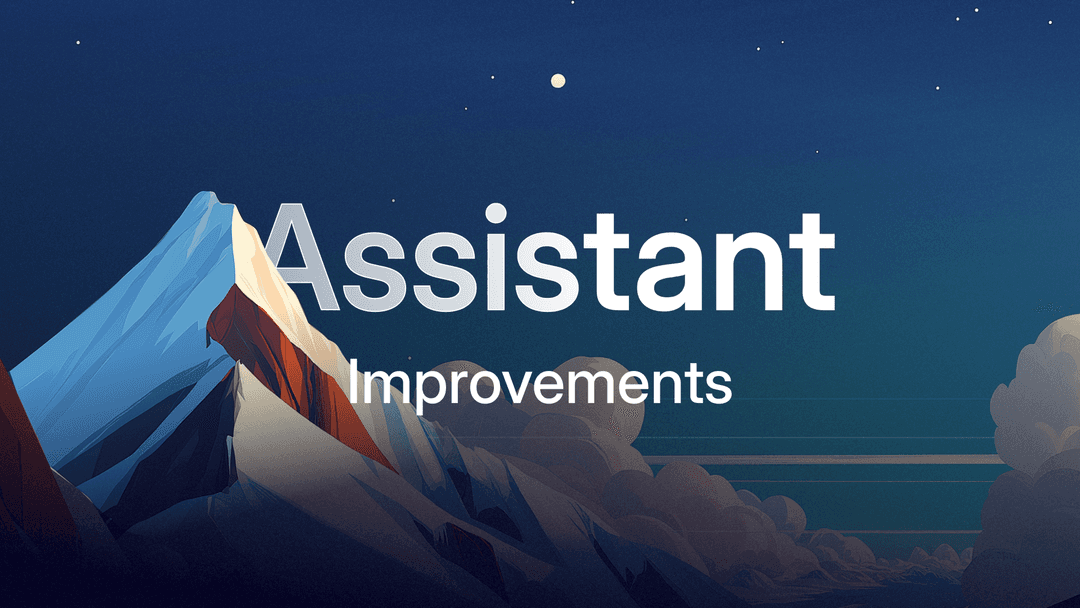
Inside our effort to improve the Mintlify assistant
A data-driven look at improving the assistant, powered by ClickHouse and deeper feedback analysis.
December 12, 2025Patrick Foster
Software Engineer
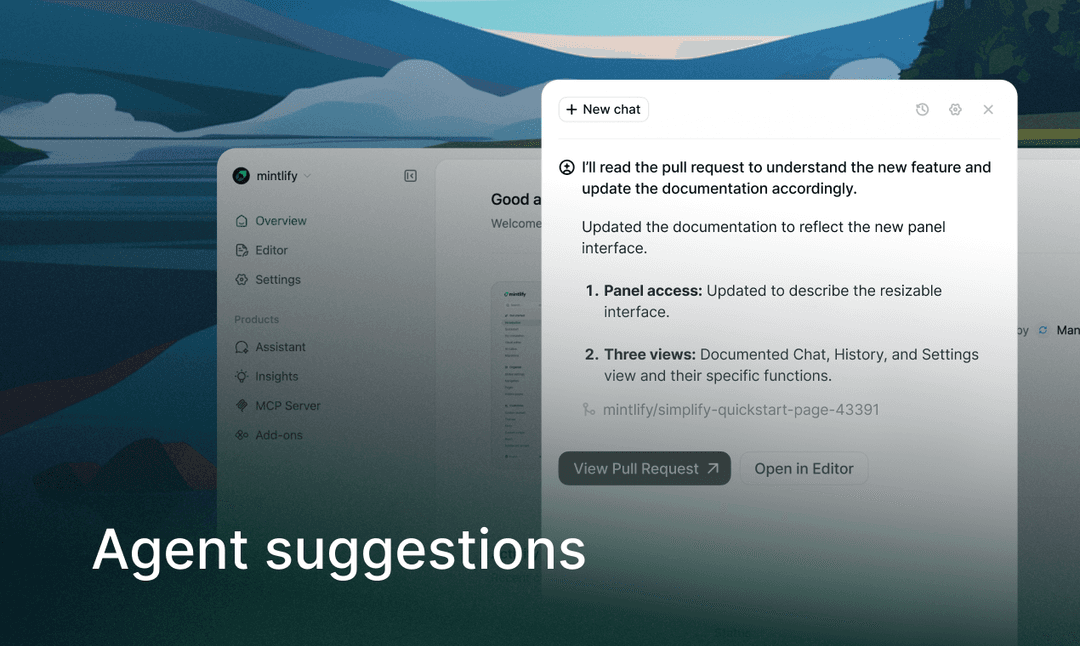
Introducing the next step towards self-updating docs
The agent now monitors your codebase, proactively identifies documentation updates, and surfaces needed suggestions to your team.
December 8, 2025Han Wang
Co-Founder
Emma Adler
Contributor @ Hackmamba